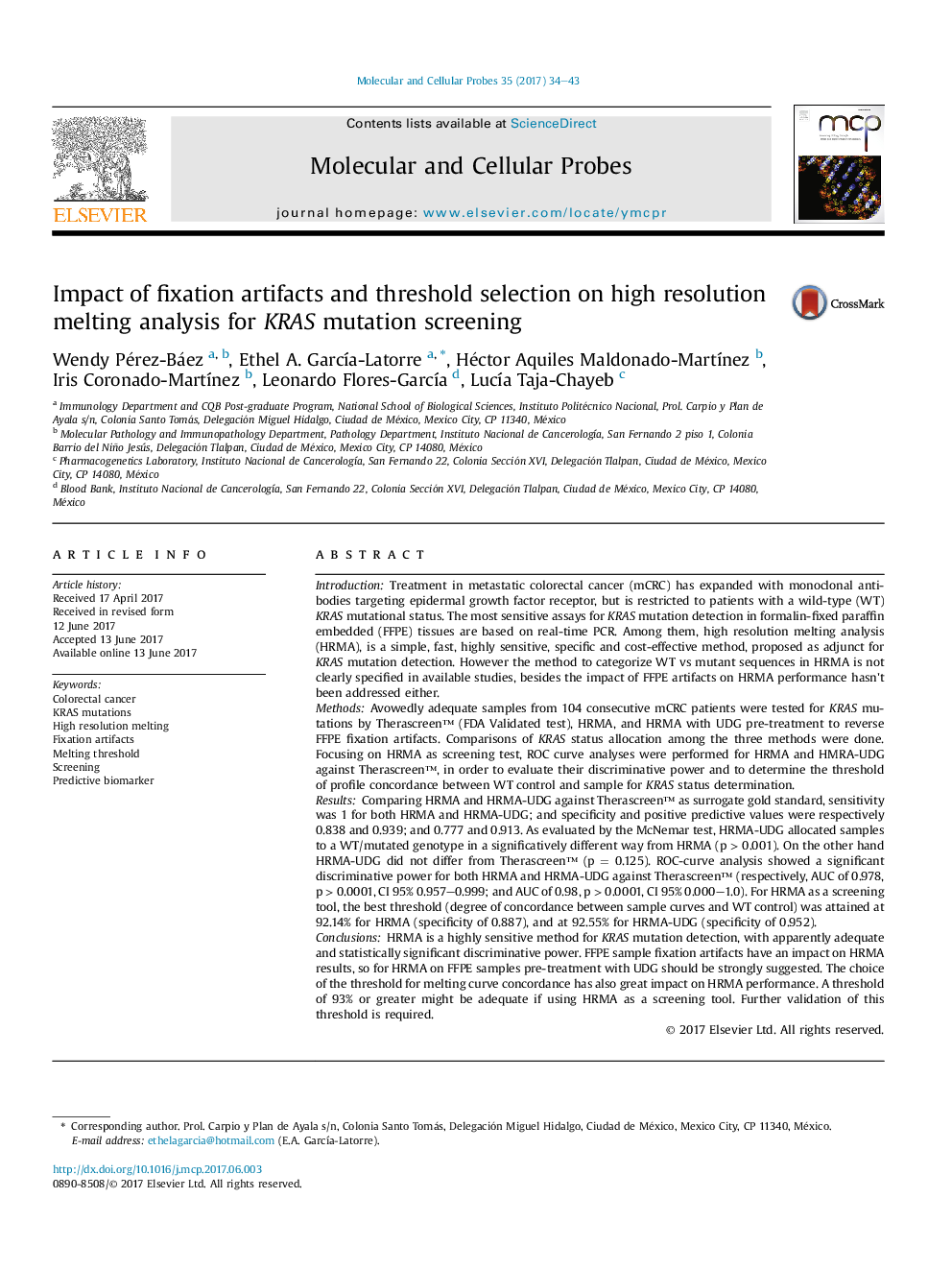| کد مقاله | کد نشریه | سال انتشار | مقاله انگلیسی | نسخه تمام متن |
|---|---|---|---|---|
| 5534470 | 1551168 | 2017 | 10 صفحه PDF | دانلود رایگان |

- HRMA is a highly sensitive, cost-effective, easy and fast test for mutation detection.
- HRMA is more suitable for screening because of its limitations for precise genotyping.
- There is little information on the impact on HRMA performance of fixation artifacts.
- Explicit thresholds for concordance between control and sample profiles are lacking.
- We explore these issues on HRMA screening performance, for their further validation.
IntroductionTreatment in metastatic colorectal cancer (mCRC) has expanded with monoclonal antibodies targeting epidermal growth factor receptor, but is restricted to patients with a wild-type (WT) KRAS mutational status. The most sensitive assays for KRAS mutation detection in formalin-fixed paraffin embedded (FFPE) tissues are based on real-time PCR. Among them, high resolution melting analysis (HRMA), is a simple, fast, highly sensitive, specific and cost-effective method, proposed as adjunct for KRAS mutation detection. However the method to categorize WT vs mutant sequences in HRMA is not clearly specified in available studies, besides the impact of FFPE artifacts on HRMA performance hasn't been addressed either.MethodsAvowedly adequate samples from 104 consecutive mCRC patients were tested for KRAS mutations by Therascreen⢠(FDA Validated test), HRMA, and HRMA with UDG pre-treatment to reverse FFPE fixation artifacts. Comparisons of KRAS status allocation among the three methods were done. Focusing on HRMA as screening test, ROC curve analyses were performed for HRMA and HMRA-UDG against Therascreenâ¢, in order to evaluate their discriminative power and to determine the threshold of profile concordance between WT control and sample for KRAS status determination.ResultsComparing HRMA and HRMA-UDG against Therascreen⢠as surrogate gold standard, sensitivity was 1 for both HRMA and HRMA-UDG; and specificity and positive predictive values were respectively 0.838 and 0.939; and 0.777 and 0.913. As evaluated by the McNemar test, HRMA-UDG allocated samples to a WT/mutated genotype in a significatively different way from HRMA (p > 0.001). On the other hand HRMA-UDG did not differ from Therascreen⢠(p = 0.125). ROC-curve analysis showed a significant discriminative power for both HRMA and HRMA-UDG against Therascreen⢠(respectively, AUC of 0.978, p > 0.0001, CI 95% 0.957-0.999; and AUC of 0.98, p > 0.0001, CI 95% 0.000-1.0). For HRMA as a screening tool, the best threshold (degree of concordance between sample curves and WT control) was attained at 92.14% for HRMA (specificity of 0.887), and at 92.55% for HRMA-UDG (specificity of 0.952).ConclusionsHRMA is a highly sensitive method for KRAS mutation detection, with apparently adequate and statistically significant discriminative power. FFPE sample fixation artifacts have an impact on HRMA results, so for HRMA on FFPE samples pre-treatment with UDG should be strongly suggested. The choice of the threshold for melting curve concordance has also great impact on HRMA performance. A threshold of 93% or greater might be adequate if using HRMA as a screening tool. Further validation of this threshold is required.
Journal: Molecular and Cellular Probes - Volume 35, October 2017, Pages 34-43